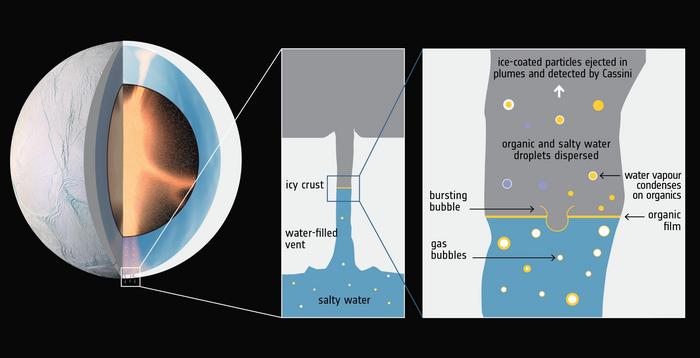A study led by researchers from the University of Washington in Seattle and the Freie Universität Berlin has shown that upcoming space missions to the icy moons of Saturn and Jupiter may be able to detect signs of life using individual ice grains ejected from these planetary bodies. The study, published in Science Advances, provides new hope in the search for extraterrestrial life within our solar system.
The ice-encrusted oceans of moons like Enceladus, orbiting Saturn, and Europa, orbiting Jupiter, have long been considered prime candidates for harboring life beyond Earth. The new lab-based study demonstrates that even a tiny fraction of cellular material could be identified by instruments onboard spacecraft headed to these moons.
Fabian Klenner, lead author and postdoctoral researcher at the University of Washington, stated, “For the first time we have shown that even a tiny fraction of cellular material could be identified by a mass spectrometer onboard a spacecraft. Our results give us more confidence that using upcoming instruments, we will be able to detect lifeforms similar to those on Earth, which we increasingly believe could be present on ocean-bearing moons.”
The study focused on simulating the detection of a common bacterium, Sphingopyxis alaskensis, which is found in cold environments and can survive with few nutrients, making it a suitable candidate for potential life on icy moons. Researchers used an experimental setup that sent a thin beam of liquid water into a vacuum, where it disintegrated into droplets. They then used a laser beam and mass spectral analysis to mimic what instruments on future space probes will detect.
The results showed that instruments like the SUrface Dust Analyzer, set to be onboard NASA’s Europa Clipper mission launching in October, can detect cellular material in one out of hundreds of thousands of ice grains. This finding suggests that analyzing single ice grains, where biomaterial may be concentrated, is more successful than averaging across a larger sample containing billions of individual grains.
Recent studies have also revealed evidence of phosphate on Enceladus, indicating that this planetary body now appears to contain energy, water, phosphate, other salts, and carbon-based organic material, making it increasingly likely to support lifeforms similar to those found on Earth.
The authors hypothesize that if bacterial cells are encased in a lipid membrane, like those on Earth, they would form a skin on the ocean’s surface. On an icy moon where the ocean is connected to the surface through cracks in the ice shell, the vacuum of outer space would cause the subsurface ocean to boil, and gas bubbles rising through the ocean would burst at the surface, incorporating cellular material into ice grains within the plume.
Frank Postberg, senior author and professor of planetary sciences at the Freie Universität Berlin, said, “With suitable instrumentation, such as the SUrface Dust Analyzer on NASA’s Europa Clipper space probe, it might be easier than we thought to find life, or traces of it, on icy moons. If life is present there, of course, and cares to be enclosed in ice grains originating from an environment such as a subsurface water reservoir.”
The study’s findings provide a plausible scenario for how bacterial cells can be incorporated into icy material formed from liquid water on Enceladus or Europa and then emitted into space. As future missions, like the Europa Clipper, prepare to explore these icy moons in greater detail, the possibility of detecting extraterrestrial life has become more tangible than ever before.


